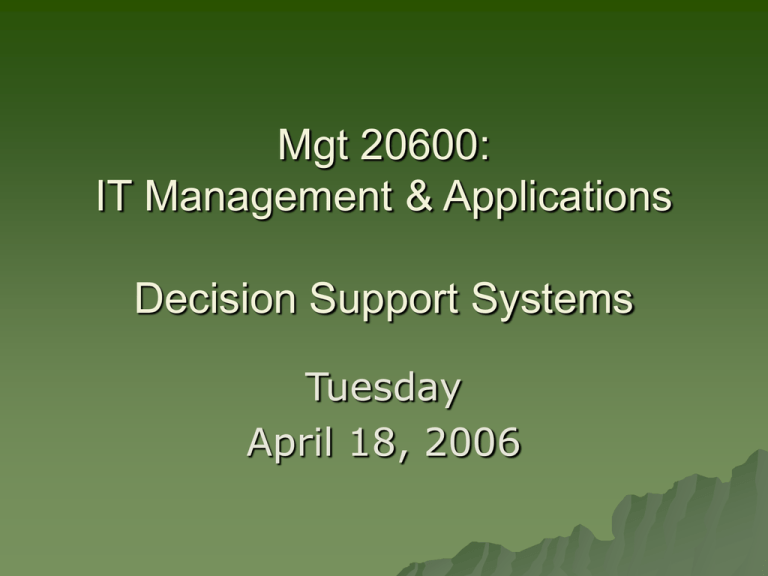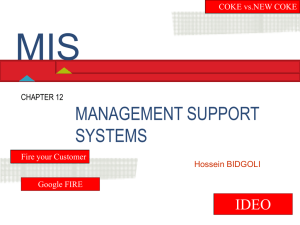Mgt 20600: IT Management
advertisement

Mgt 20600: IT Management & Applications Decision Support Systems Tuesday April 18, 2006 Reminders Reading – For today Fundamentals text, Chapter Six, Information and Decision Support Systems Homework – Homework Five Decision Support Systems Due Friday, April 21st by 5pm Exam 2 – Tuesday, April 25th – 75 points – Similar types of questions as on Exam 1 – Covers Telecom & Networks (Ch.4), Databases (Ch.3), MIS & Decision Support Systems (Ch.6) Next week: Exam 2 Decision Making as a Component of Problem Solving How Decision Making Relates to Problem Solving Decision Making as a Component of Problem Solving Decision-making phase: first part of problem-solving process – Intelligence stage: potential problems or opportunities are identified and defined – Design stage: alternative solutions to the problem are developed – Choice stage: a course of action is selected Decision Making as a Component of Problem Solving Problem solving: a process that goes beyond decision making to include the implementation stage Implementation stage: a solution is put into effect Monitoring stage: decision makers evaluate the implementation Programmed Versus Nonprogrammed Decisions Programmed decisions – Decisions made using a rule, procedure, or quantitative method – Easy to computerize using traditional information systems – Example? Nonprogrammed decisions – Decision that deals with unusual or exceptional situations – Not easily quantifiable – Example? Optimization, Satisficing, and Heuristic Approaches Optimization model: a process that finds the best solution, usually the one that will best help the organization meet its goals Satisficing model: a process that finds a good—but not necessarily the best— problem solution Heuristics: commonly accepted guidelines or procedures that usually find a good solution An Overview of Decision Support Systems A DSS is an organized collection of people, procedures, software, databases, and devices used to support problem-specific decision making and problem solving The focus of a DSS is on decisionmaking effectiveness when faced with unstructured or semistructured business problems Capabilities of a Decision Support System Support all problem-solving phases Support different decision frequencies Support different problem structures Support various decision-making levels Capabilities of a Decision Support System (continued) Decision-Making Level A Comparison of DSS and MIS Comparison of DSSs and MISs A Comparison of DSS and MIS (continued) Comparison of DSSs and MISs Components of a Decision Support System Conceptual Model of a DSS Components of a Decision Support System Database External database access Access to the Internet and corporate intranet, networks, and other computer systems Model base: provides decision makers access to a variety of models and assists them in decision making Dialogue manager: allows decision makers to easily access and manipulate the DSS and to use common business terms and phrases Intelligence Phase Support: Excel and Access Excel – List capabilities: Sorting, filtering – Pivot tables – Charting Access – Queries – Reports Design Phase Support: Excel Excel – What if analysis Data tables Scenario manager Stages of the Decision Making Process: Choice Selecting a course of action – Excel Solver – Expert systems Intended to perform at the level of a human expert in a particular domain – Decision Tree Analysis Add-in to Excel that facilitates construction of decision trees Common Expert System Architecture User Expert Knowledge User Interface Blackboard Inference Engine Knowledge Engineer Knowledge Base User Environment Development Environment Documented Knowledge Decision Tree Analysis Output Group Support Systems Group support system (GSS) – Consists of most elements in a DSS, plus software to provide effective support in group decision making – Also called group decision support system or computerized collaborative work system Characteristics of a GSS That Enhance Decision Making Special design Ease of use Flexibility Decision-making support Anonymous input Reduction of negative group behavior Parallel communication Automated record keeping GSS Software Often called groupware or workgroup software Helps with joint workgroup scheduling, communication, and management Examples: Lotus Notes, Microsoft’s NetMeeting, Microsoft Exchange, NetDocuments Enterprise, Collabra Share, OpenMind, TeamWare GSS Alternatives GSS Alternatives GSS Alternatives The GSS Decision Room Group Support System Example Meeting, Brainstorming, and Decision Making Tools for groups Executive Support Systems Executive support system (ESS): specialized DSS that includes all hardware, software, data, procedures, and people used to assist senior-level executives within the organization Executive Support Systems in Perspective Tailored to individual executives Easy to use Drill-down capable Support the need for external data Can help when uncertainty is high Future-oriented Linked to value-added processes Capabilities of Executive Support Systems Support for defining an overall vision Support for strategic planning Support for strategic organizing and staffing Support for strategic control Support for crisis management Executive Support Systems – Xcelsius – Executive Dashboard Identify, track, trend, and correct problems as managers evaluate the health of key areas of their organization Identify operational efficiencies Proactively identify and apply corrective measures Executive Dashboard Features Dashboard Screen: The dashboard page displays the overall health of key performance indicators. Each box represents a key performance indicator (KPI) and the health for corresponding periods. The default executive dashboard shown can be unique to the individual logged in, or shared by the entire organization.







